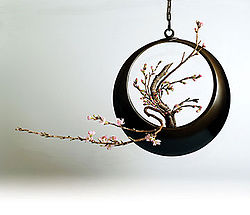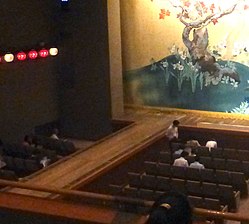花道
Appearance
Chinese
[edit]flower; blossom; to spend flower; blossom; to spend; fancy pattern |
direction; way; method direction; way; method; road; path; principle; truth; reason; skill; Tao (of Taoism); a measure word; to say; to speak; to talk | ||
|---|---|---|---|
| trad. (花道) | 花 | 道 | |
| simp. #(花道) | 花 | 道 | |
Pronunciation
[edit]- Mandarin
- (Standard Chinese)+
- Hanyu Pinyin:
- Zhuyin: ㄏㄨㄚ ㄉㄠˋ
- Tongyong Pinyin: huadào
- Wade–Giles: hua1-tao4
- Yale: hwā-dàu
- Gwoyeu Romatzyh: huadaw
- Palladius: хуадао (xuadao)
- Sinological IPA (key): /xu̯ä⁵⁵ tɑʊ̯⁵¹/
- (Standard Chinese)+
- Cantonese
- (Standard Cantonese, Guangzhou–Hong Kong)+
- Jyutping: faa1 dou6
- Yale: fā douh
- Cantonese Pinyin: faa1 dou6
- Guangdong Romanization: fa1 dou6
- Sinological IPA (key): /faː⁵⁵ tou̯²²/
- (Standard Cantonese, Guangzhou–Hong Kong)+
Noun
[edit]花道
Synonyms
[edit]- 插花 (chāhuā)
Japanese
[edit]Etymology 1
[edit]
| Kanji in this term | |
|---|---|
| 花 | 道 |
| か Grade: 1 |
どう Grade: 2 |
| kan'on | goon |
/kwadau/ → /kwadɔː/ → /kwadoː/ → /kadoː/
From Middle Chinese 花道 (MC xwae dawX).
Alternative forms
[edit]- 華道 (kadō)
Pronunciation
[edit]Noun
[edit]Usage notes
[edit]This term became more common during the Edo period as a synonym for ikebana, but with an emphasis on the elements of mental discipline.[1][2][3]
The 華道 spelling may be more common for the kadō reading, to more clearly distinguish from the hanamichi reading below.
Etymology 2
[edit]
| Kanji in this term | |
|---|---|
| 花 | 道 |
| はな Grade: 1 |
みち Grade: 2 |
| kun'yomi | |
Compound of 花 (hana, “flower”) + 道 (michi, “road, way”).[1][2][4]
Likely derives from the early use of a hanamichi as a kind of walkway from the stage down into the audience, giving performers access to the audience in order to receive flowers.[1][2]
Pronunciation
[edit]Noun
[edit]- (theater) an extension of a stage that stretches into the audience, usually only in kabuki and most often along the left side of the theater, used mainly to enter and exit the stage
References
[edit]- ↑ 1.0 1.1 1.2 1.3 1.4 Matsumura, Akira, editor (2006), 大辞林 [Daijirin] (in Japanese), Third edition, Tokyo: Sanseidō, →ISBN
- ↑ 2.0 2.1 2.2 Shōgaku Tosho (1988) 国語大辞典(新装版) [Unabridged Dictionary of Japanese (Revised Edition)] (in Japanese), Tōkyō: Shogakukan, →ISBN
- ^ “花道”, in 改訂新版 世界大百科事典 (Kaitei Shinpan Sekai Dai-hyakka Jiten, “Heibonsha World Encyclopedia Revised Edition”)[1] (in Japanese), Tōkyō: Heibonsha, 2007, →ISBN
- ^ Matsumura, Akira (1995) 大辞泉 [Daijisen] (in Japanese), First edition, Tokyo: Shogakukan, →ISBN
Categories:
- Chinese lemmas
- Mandarin lemmas
- Cantonese lemmas
- Chinese nouns
- Mandarin nouns
- Cantonese nouns
- Chinese terms with IPA pronunciation
- Chinese terms spelled with 花
- Chinese terms spelled with 道
- Japanese terms spelled with 花 read as か
- Japanese terms spelled with 道 read as どう
- Japanese terms read with on'yomi
- Japanese terms borrowed from Middle Chinese
- Japanese terms derived from Middle Chinese
- Japanese terms with IPA pronunciation
- Japanese lemmas
- Japanese nouns
- Japanese terms historically spelled with わ
- Japanese terms with multiple readings
- Japanese terms spelled with first grade kanji
- Japanese terms spelled with second grade kanji
- Japanese terms with 2 kanji
- Japanese terms spelled with 花 read as はな
- Japanese terms spelled with 道 read as みち
- Japanese terms read with kun'yomi
- Japanese compound terms
- ja:Theater

